As an Amazon Associate I earn from qualifying purchases.
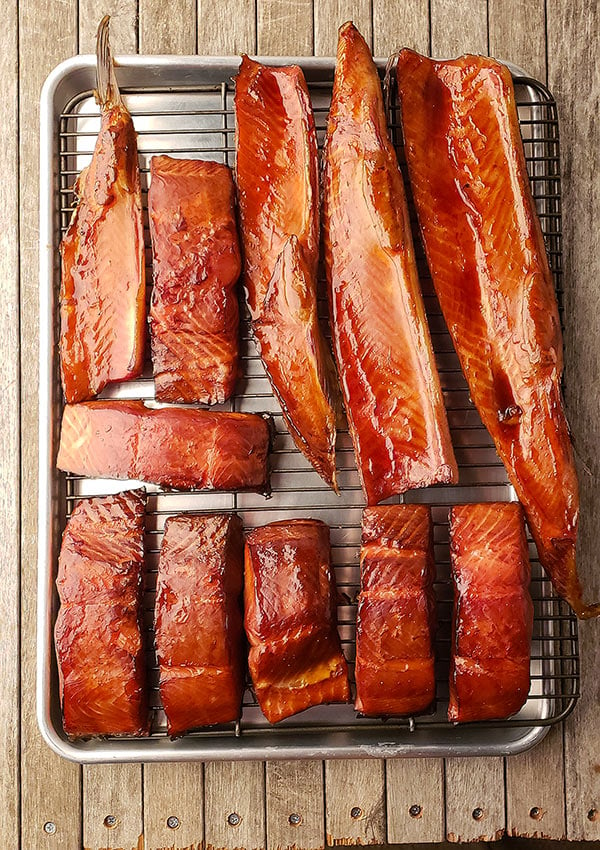
I smoke a lot of salmon, and I am proud of this recipe, although it would be the height of arrogance to say that what I do is the end-all, be-all of salmon smoking recipes. Lots of people smoke their salmon in lots of ways, and many of them are good. But I’ve been smoking fish for many years, and I’ve developed a system that works well.
Keep in mind this is a hot-smoking recipe. Cold smoking, which is the kind of slice-able smoked fish you get in fancy boxes from Scotland is an entirely different thing.
Almost everyone in Salmon Country hot smokes their fish. If you’re unfamiliar with hot-smoked fish, think about those golden smoked whitefish you see in delicatessens; those are hot smoked.
How do you eat it? Well, you can just eat it plain, or you can flake it and make it into a smoked salmon salad, you can pound it with butter and make salmon rillettes, serve it in deviled eggs, tossed with pasta… you get the point.
Here’s what you need to get started:
- A smoker. I’ve uses a Traeger and a Bradley. Both are good. No matter what smoker you use, you will need to be able to a) know your smoking chamber’s temperature, and b) control the heat, at least in a rough sense.
- Wood. The only downside to a Traeger smoker is that you need to use their wood pellets. As a guy who used a Brinkmann wood-fired BBQ for years, fueling it with scraps of almond and other fruit woods, buying wood can be annoying, but you get better precision with this method. I prefer to use alder wood for my salmon, but apple, cherry, oak or maple work fine.
- Salt. Buy a box of kosher salt from the supermarket. Do not use regular table salt, as it contains iodide and anti-caking agents that will give your salmon an “off” flavor. I use Diamond Crystal, which is cut finer than Morton’s.
- Something sweet — salmon love sweet. I prefer to sweeten my smoked salmon with birch syrup; It’s just like maple syrup, only tapped from birch trees instead. Super cool stuff. But maple syrup is just as good. Just use real maple syrup, OK? Not the imitation crap. Honey works, too.
- A large plastic container. Buy the big, flat ones from the supermarket. They stack easily in a normal fridge, so you can have two different brines going. And they clean easily and are pretty cheap.
- A wire rack. You need to rest your brined fish on a rack with plenty of air circulation to form the all-important pellicle (more on that in a bit), and you will use it to rest the smoked fish before storing it.
- A basting brush. You probably already have this in your kitchen, but if not, pick one up. Get the flat kind, like you use to paint detail on window trim.
When you are ready to start, you will need smallish pieces of salmon about 1/4 to 1/2 pound each. Any salmonid fish will work with this recipe. I’ve done it with king salmon, sockeye, coho, and pink salmon, dolly varden, plus kokanee, steelhead and Lahontan trout.
There is no reason it would not work with chum salmon or any other char or trout species. And yes, it works with farmed Atlantic salmon, but I never eat the stuff.
I prefer to smoke salmon with its skin on, but I’ve done it with skinless pieces and it works fine.
Smoked Salmon
Ingredients
- 5 pounds salmon, trout or char
- Birch or maple syrup for basting
BRINE
- 1 quart cool water
- 1/3 cup Diamond Crystal kosher salt, about 2 ounces of any kosher salt
- 1 cup brown sugar
Instructions
- Mix together the brine ingredients and place your fish in a non-reactive container (plastic or glass), cover and put in the refrigerator. This curing process eliminates some of the moisture from the inside of the fish while at the same time infusing it with salt, which will help preserve the salmon.
- You will need to cure your salmon at least 4 hours, even for thin fillets from trout or pink salmon. In my experience, large trout or char, as well as pink, sockeye and silver salmon need 8 hours. A really thick piece of king salmon might need as much as 36 hours in the brine. Never go more than 48 hours, however, or your fish will be too salty. Double the brine if it's not enough to cover the fish.
- Take your fish out of the brine, rinse it briefly under cold running water, and pat it dry. Set the fillets on your cooling rack, skin side down. Ideally you'd do this right under a ceiling fan set on high, or outside in a cool, breezy place. By "cool" I mean 60°F or cooler. Let the fish dry for 2 to 4 hours (or up to overnight in the fridge). You want the surface of the fish to develop a shiny skin called a pellicle. This is one step many beginning smokers fail to do, but drying your cured, brined fish in a cool, breezy place is vital to properly smoking it. The pellicle, which is a thin, lacquer-like layer on top of the fish, seals it and offers a sticky surface for the smoke to adhere to. Don't worry, the salt in the brine will protect your fish from spoilage. Once you have your pellicle, you can refrigerate your fish for a few hours and smoke it later if you'd like.
- Start by slicking the skin of your fish with some oil, so it won't stick to the smoker rack. Know that even though this is hot smoking, you still do not want high temperatures. Start with a small fire and work your way up as you go. It is important to bring the temperature up gradually or you will get that white albumin "bleed" on the meat. I can control my heat with my smoker, so I start the process between 140°F and 150°F for up to an hour, then finish at 175°F for a final hour or two. NOTE: What my smoker is set at is not necessarily what the actual temperature is. Smoking is an art, not a science. To keep temperatures mild, always put water in your drip pan to keep the temperature down. If your smoker is very hot, like a Traeger can get, put ice in the tray.
- After an hour in the smoker, baste the fish with birch or maple syrup, or honey; do this every hour. This is a good way to brush away any albumin that might form. In most cases, you will get a little. You just don't want a ton of it. Even if you can't control your temperature this precisely, you get the general idea. You goal should be an internal temperature of about 130°F to 140°F. (Incidentally, yes, I keep the smoke on the whole time. I don't find this to be too much smoke, but if you want a lighter smoke, finish the salmon without smoke or in a 200°F oven.)
- You must be careful about your heat. Other than failing to dry your salmon long enough, the single biggest problem in smoking salmon is too high heat. If you've ever seen salmon "bleed" a white, creamy substance, that's a protein called albumin. If you see lots of it, you've screwed up; a little is normal. Here's what happens: If you cook a piece of salmon at too high a heat, the muscle fibers in the meat contract so violently that they extrude albumin, which immediately congeals on the surface of the fish. It's ugly, and it also means your salmon will be drier than it could have been. You prevent this with a solidly formed pellicle, and by keeping your heat gentle. If you let your heat get away from you and you do get a white mess on your salmon, all is not lost. Just flake it out and make salmon salad with it: The mayonnaise in the salad will mask any dryness.
- Once your fish is smoked, let it rest on the cooling rack for an hour before you put it in the fridge. Once refrigerated and wrapped in plastic, smoked fish will keep for 10 days. If you vacuum-seal it, the fish will keep for up to 3 weeks. Or freeze your fish for up to a year.
Notes
Nutrition
Nutrition information is automatically calculated, so should only be used as an approximation.
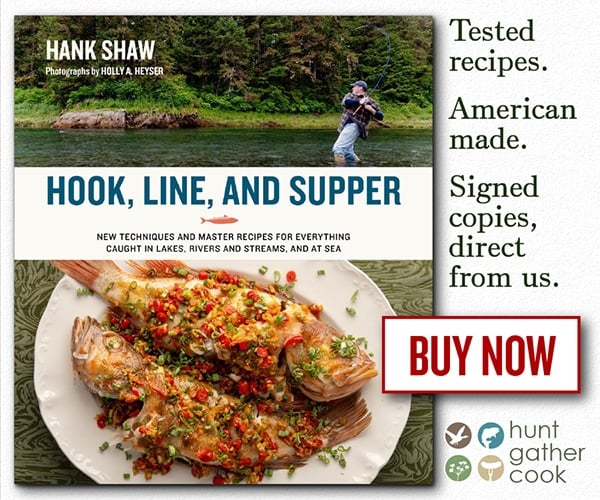



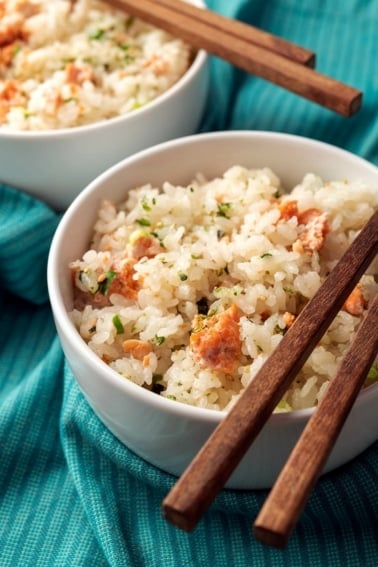
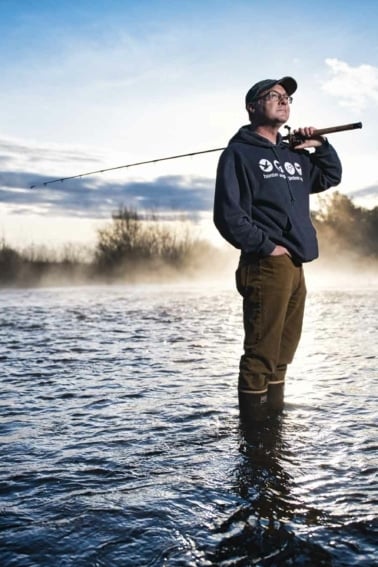
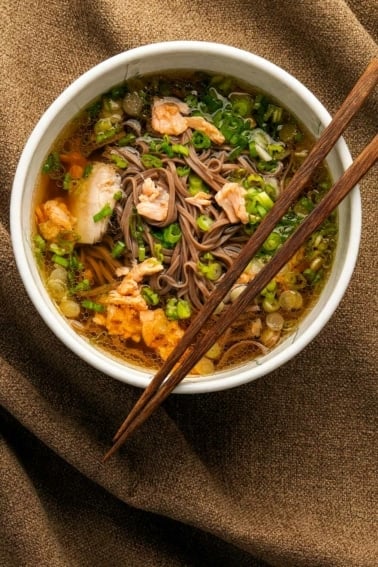
I’m very excited to try this recipe! This is my first try at smoking salmon. I am looking forward to the end results, and will comment about my end results. Thank you for sharing this recipe!!
Hubby & I have made this recipe numerous times with great success (except once, when hubby failed to follow directions and I was gone for part of the day). It has always been a huge success with family & friends and I have shared the recipe with several people. I have just put 10 pounds of salmon into brine to smoke tomorrow!!
So you leave the skin on the salmon?
Ben: yes.
Do you remove the scales?
Kenneth: No. They help prevent the fish from sticking to the smoker grates.
Simple and amazing recipe.
I loved the smoked salmon recipe with the real honey. It was delicious!!!!!!!!!!!!!
is this how you spell ‘luscious’??
thanks for sharing
Hank, this was the best recipe, as simple recipes go, that I’ve had for smoking salmon. When I did it I accidentally bought Steelhead because it was in the Costco case right next to the salmon, it was wonderful, won’t do salmon anymore. I thought the honey gave it more depth as well. I did a 2.5 lb steelhead cut into 4 pieces, 24 hour brine and 24 hour drying in frig., 3.5 hours on the Traeger 170 with super smoke the entire time. Last 20 mins took it to 200, to get internal temp to 130. My Traeger won’t go down to 140, 165 is lowest. Thanks!
Your recipe sounds great! I have been smoking salmon for 10 years and I don’t have a pellet grill. I use a Weber kettle grill with the snake method. If not familiar with that, google charcoal snake method. Doing a 1×1 snake, I can keep the temp from 110-140 degrees with the dampers avoiding much Albumin. I actually have four whole filets drying in the fridge now.
I noticed in your smoked salmon recipe that you list no carbs,there are carbs in brown sugar?
I have been buying Costco skinless farmed salmon – I cut off the thin end for gravlax ( a different recipe! ) and the rest I smoke using this recipe – 24 hours in the brine and then 2 hours in a very basic electric smoker at 215 degrees. I use pellets in the smoker because they are easy and cheap. about 1/3 cup of pellets every 45 minutes. I put the fillets on 1/4 sheet racks and put it on the smoker with the rack. Be aware that the salmon is not nearly as good when it is hot. Put in the fridge and only eat it when it is cold. AMAZING. Thank you Hank ( and Elise for sending me to you ) . If you have access to a smoker and a piece of salmon – make this ASAP – you won’t be disappointed,